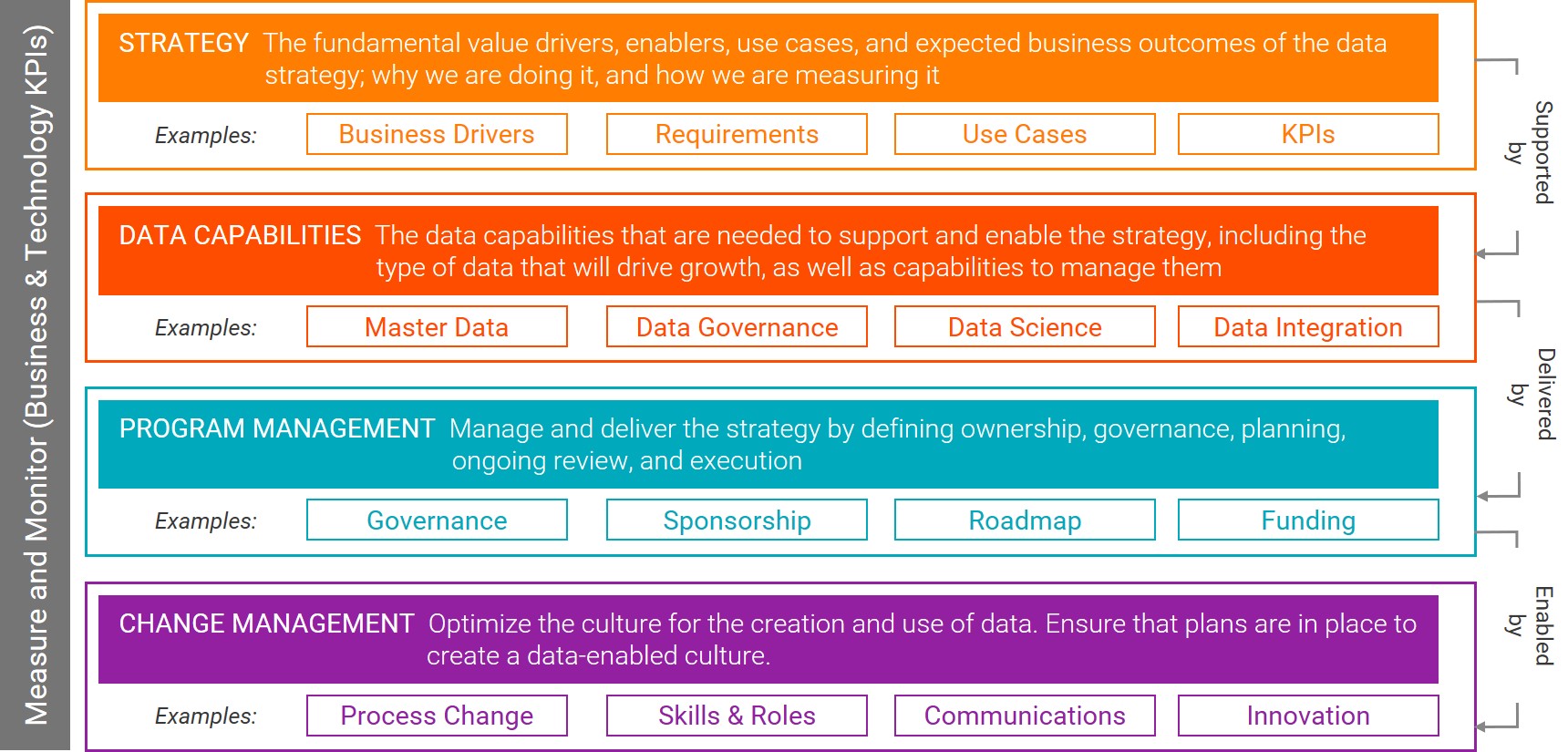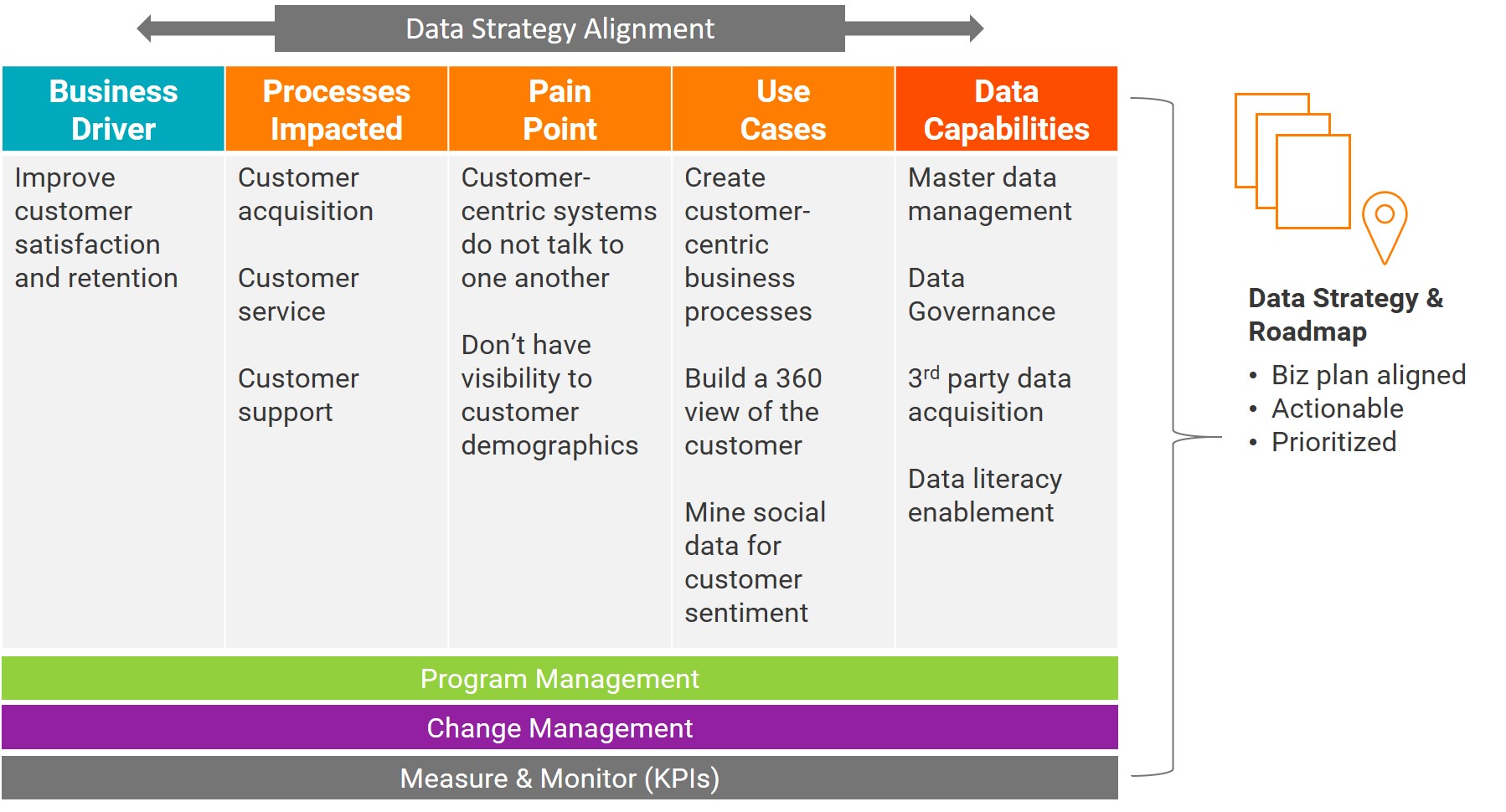Data Strategy
What is a Data Strategy?
If your team is struggling to implement a data strategy, you’re not alone. Few people know what a data strategy is, much less how to develop one.
Let’s start simply with a definition:
A data strategy defines how an organization achieves specific business goals through the strategic use of its data assets.
When looking at strategies from a wide-angle view, a data strategy sits between the overall business strategy and the data management or data governance strategy. It’s defining a plan that describes how an organization will maximize its data to generate the greatest business impact. Realistically, the best data strategies aren’t actually data strategies. They’re business-problem strategies.
Most enterprises are only beginning to explore how harnessing and mining their data can change their businesses and deliver great outcomes. Companies with data-centric business models—like Airbnb and Tesla—have grown up with data strategy embedded in their business strategy. It gives them an incredible advantage. More traditional companies don’t have that advantage and are now looking to make data a more central component to how they do business.
A data strategy informs and propels:
- Customer-centricity
- Business model innovation
- Big data and analytics
- Cloud migration
- Security
- Compliance
- Risk management
Pair IT and Business Experts for a Strong Foundation
When creating a data strategy, business and IT must be in lock step. The collaboration between business and IT has to be about solving problems together, from the very beginning and throughout the journey.
Business stakeholders bring domain expertise. They own the targets and they understand the business processes that combine to deliver those targets. Business stakeholders know their customers. And they know the most important questions that need answering; the critical decisions they need to make more quickly; the critical processes that need to be optimized; and the real business problems that need solving immediately.
IT owns the enabling technology stack. IT understands the existing processes and systems today, as well as the potential for new technologies to enable new processes. IT must determine how to apply these technologies to get those answers, accelerate decision-making, and optimize those processes.
Working together, the business and IT can define the outcomes they want from a data strategy. Very simply they must answer: What will the data strategy achieve for the business?
Get Input from Stakeholders for a Comprehensive Plan
Before defining the data strategy, business and IT will have a series of discovery meetings designed to identify goals. This initial work lays a foundation for a data strategy that will best serve specific business needs. Communicating clearly with stakeholders and gaining buy-in and trust is vital. During meetings and conversations with stakeholders, keep these guidelines in mind.
Set the context. Show you’re here to deliver business outcomes.
Learn their goals, target state, and key obstacles. Understand why they need to solve these challenges. You can identify these opportunities by asking things like What’s the one question about our customers you wish you could answer? Or, what one problem would you love to solve right now?
Understand their core processes. Start with a broad view, then drill down in later discussions. An example for Sales and Marketing: Find out how opportunities are created and converted.
Capture their metrics and the language of success. Design a strategy to move these metrics—and use their language in all the planning.
Define the outcomes and milestones together. Agree on what good looks like and the milestones that will show you’re getting there.
Look for the most likely gaps and traps. You don’t need a thorough gap analysis yet, but try to get a sense of the big challenges and where the most work will have to happen. Moving ahead with a data strategy project before determining whether you have the right information in the right condition to support the project can lead to failure.
Encourage a wider perspective. Show how the capabilities discussed touch other processes, departments, and stakeholders. Discuss why compromise in their domain might contribute to achieving the CEO’s goals.
Agree on next steps. Don’t leave without clear actions for both sides. Start thinking about assembling the right team.
Summarize the meeting in writing. Capture the entire conversation and the next steps, whether in a meeting report or an informal email. Circle back to see that it accurately reflects the discussion.
Communicate regularly. After the meeting, work hand-in-hand with your business partner as the data strategy project rolls out. What’s working and what’s not working? How should you iterate the project based on early learnings? Make these decisions together.
Use Informatica’s Data Strategy Framework
A data strategy framework provides a logical structure for discussion and collecting input. These essential building blocks spell out the categories of “ingredients” you must consider in order to construct the “recipe” of your strategy. Our Data Strategy Framework defines four categories:

To bring these categories to life for your company, we suggest that you initially follow a process of decomposing each business driver to the data capabilities that support it. This is often best achieved in a Workshop setting.
In the example below, we identify “Improve Customer Satisfaction & Retention” as the business driver. Consider the processes that are impacted, relevant pain points, and use cases:

Repeat this exercise for each business strategy. With a collection of data strategies now in hand, you can compile it into a roadmap – identifying common capabilities supporting multiple business objectives, and mapping these for development according to business priority. Here, a laser focus on business value is essential.
Define a Roadmap to Share
Just as product teams need a roadmap for a new release, the data strategy needs a constantly updated roadmap that everyone can use as reference. Following these best practices can help create that roadmap.
Think big, start small
1. Don’t try to sell a big, holistic data strategy from the start.
While an enterprise-wide data strategy is an important part of the endgame, you can’t start there. It’s too big a task; it’s far harder to get business partners to engage with you; and you haven’t yet built confidence in your organization’s ability to deliver value through data strategy.
2. Focus on critical business opportunities or risks.
Start with the most important business challenges that can best be addressed through more effective use of data. By definition, these will be best aligned with the strategic goals of the company. But some of these challenges are better starting places than others. Possible options are:
- Make products easier to try and buy
- Increase decision-making speed and accuracy
- Increase customer satisfaction and customer retention
- Increase profitability and reduce cost of sales and support
- Differentiate product offerings
- Improve regulatory compliance
3. Look for quick wins.
Nothing gets people on board faster than some quick, clear data strategy wins. Better prediction of customer churn. Reducing product returns. Accelerating the supply chain. Improving regulatory compliance. These are the kinds of wins that get attention and earn support for more investment in data strategy.
But starting small doesn’t mean forgetting your bigger vision. Ideally, you want to find quick wins that move you toward your overarching enterprise data strategy. Consciously use these important early projects as building blocks for the bigger play.
4. Keep everyone’s eyes on the prize.
Data-driven digital transformation is hard. You’re asking people to change the way they work and the processes they understand. To make it through, evangelize a clear vision of the end goal. You want your business partners to understand your long-term roadmap—but the roadmap can’t be just phases of a big, vague project. To succeed, your roadmap needs to be a series of incremental business-value successes, each building on the one before. Lay out your vision as “wins,” not just “steps.”
Convert Business Goals to Data Strategy
Translating your chosen business goals into a data strategy will be highly specific, tailored to your situation. Think of it as working like the GPS system in a car and break it down to these three things:
Establish where you are today.
The first thing your GPS does when you turn it on is contact the satellite and determine your current position. For your data strategy, you need to know the current state of the business and try to capture it in a sentence or two, with a focus on the things that need to change.
Example: "Today we sell licensed software and maintenance contracts."
You then have to thoroughly understand the way things work today. What data drives which processes? How does the data flow? What are the dependencies and integrations? What’s the data quality status? How is it maintained?
“We sign contracts, issue license keys, install servers, set up support, etc.”
“We use a data warehouse that imports ERP data and exports to CRM …”
Too often, data strategy documents say nothing about inventory. How do you manage any kind of asset if you have no inventory of it? Companies spend millions tracking all sorts of physical assets but too often leave their data assets undiscovered.
Decide where you want to go.
After establishing your car’s current location, your GPS asks you for a destination. Similarly, once you understand the current state of the business area you’re addressing, you need to agree on a clear end state—the business outcomes you want to achieve.
Instead of making this a technical target (“We need to consolidate six CRM instances into one”), it should start with the business imperative.
“We need to determine why customers don’t renew their contracts.”
“We need to move 70 percent of our transactions online within two years.”
“We’d like to reduce product returns.”
“We need to predict customer churn earlier and more accurately.”
Once a clear goal is agreed upon, find out what processes will have to change to achieve it.
“We’ll need to rethink our opportunity-to-order capability to move transactions online and enable the free trial.”
“We’ll need a single view of all supplier contracts to aggregate spend effectively.”
That will also mean determining which systems and processes will be affected.
“ We’ll have to unify our six CRM systems into one.”
“We’ll need a central customer data store.”
“ We’ll redesign the order entry system and process for Sales.”
Map the best route to get there.
Finally, a car’s GPS provides the suggested route. This is where the data strategy gets specific, identifying the things to do to enable the desired change.
This action list should be specific and actionable:
“ We’ll re-platform to a new CRM implementation.”
“ We’ll build a customer data lake using Hadoop and feed it from CRM and transaction systems.”
“ We’ll centralize our compliance-sensitive data and track its movements.”
“ We’ll feed three existing and two new data sources into a predictive model to identify customers with high churn risk.”
Of course, the specific actions chosen at the start of a data-driven transformation may well change along the way. You may discover new obstacles or generate better ideas. The point is not to lock your team into the program, it’s to get aligned on goals and direction.
The simple GPS analogy can guide even the most complex data strategies. Know where you are. Agree on where you want to go. Agree on the steps you’ll take to get there.
Communicate and Engage the New Data Culture
Once the strategy is written, communicate it to the key stakeholders in the business—including the leaders and the front-line users whose areas are being directly affected. All-hands meetings, scheduled company webinars, small-team workshops, intranet videos, and internal blog posts or FAQs are all good communications options.
The key is to give the context of the strategy. Lead with why it’s needed, what business goals it aligns to and how it will affect the people concerned. Outline the KPIs you’ll use to measure the program. And explain the friction that inevitably comes with change and actively enlist everyone’s support. Then communicate progress at regular intervals. Let people know how things are going, outline any pivots, and keep everyone’s eyes on the prize: The business benefits that make this journey worthwhile.
Data strategy can never be a “one and done” initiative. Instead, it’s a process that continually evolves as your organization’s goals and challenges change. Leading these strategic programs isn’t easy, but the rewards are huge for companies that take control of their data. Those that treat data like a strategic asset will be the winners in every market.






